I Found 21 Creative Ways To Reuse Terracotta Pots In My Garden
Terracotta pots aren’t just for your grandma’s geraniums anymore.
With a bit of creativity, they’re transforming from simple plant homes to the unsung heroes of the garden. And let’s be honest, who doesn’t love a good garden hack?
From toad houses that offer a five-star bug buffet to cozy, contained fires that light up the night, terracotta pots are proving they’ve got versatility down to an art.
I’ve discovered that with a few tweaks here and there, these pots can become the ultimate garden multitaskers.
So, if you’re ready to give your garden a little extra oomph with items you likely already have lying around, stick with me.
1. Inventive Planting Strategies
Terracotta pots aren’t just aesthetically pleasing; they’re also incredibly versatile.
I’m excited to share some innovative ways to use these timeless pieces in your garden that go beyond the conventional.
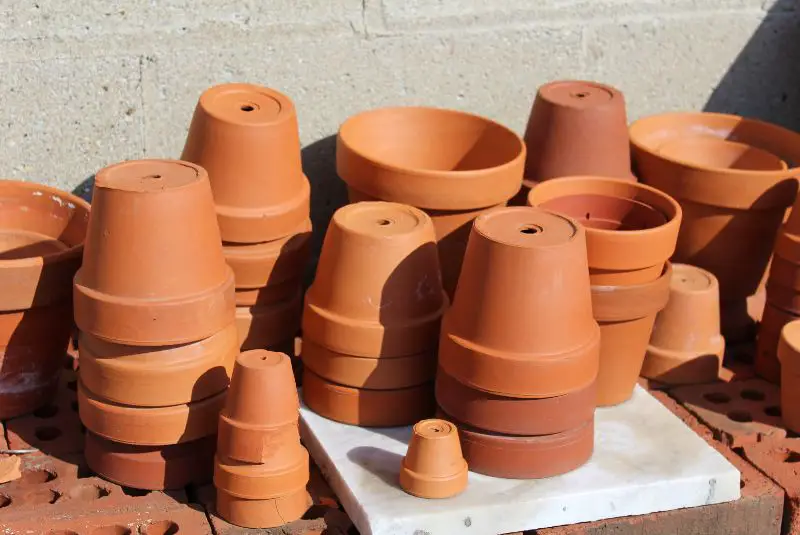
Submerged Pot Garden Beds
One of my favorite tricks involves creating a gorgeous layered look in your garden beds by partially burying terracotta pots. This technique not only adds a unique visual element but also helps with plant management.
By burying pots at different levels, you can control the growth of invasive species or manage plants with differing water needs. Plus, it’s a fantastic way to recycle broken or old pots that might otherwise go to waste.
Terracotta Pot Edging for Garden Paths
I’ve found that using terracotta pots as edging for garden paths not only defines the walkway beautifully but also adds a rustic charm to your outdoor space.
Simply place them upside down along the edges of the paths or partially bury them for stability.
This approach offers an instant visual appeal and can be used to guide visitors through your garden maze. It’s a creative way to repurpose pots while also making your garden paths pop.
Companion Planting with Terracotta Pots
Companion planting is a fantastic way to boost your garden’s health, and using terracotta pots for this purpose can take it to the next level.
I like to place pots strategically within the garden or larger containers to segregate herbs and vegetables that thrive together.
This method not only makes for an organized garden but also ensures that plants which benefit each other in terms of pest control and pollination are kept close.
Plus, it makes rotating crops a breeze. It’s a practical yet visually appealing way to enhance your garden’s productivity and beauty.
2. Garden Decor and Utility Pieces
Terracotta pots don’t just hold plants; they’re ripe for reinvention into decor and utility items that add character and functionality to any garden space.
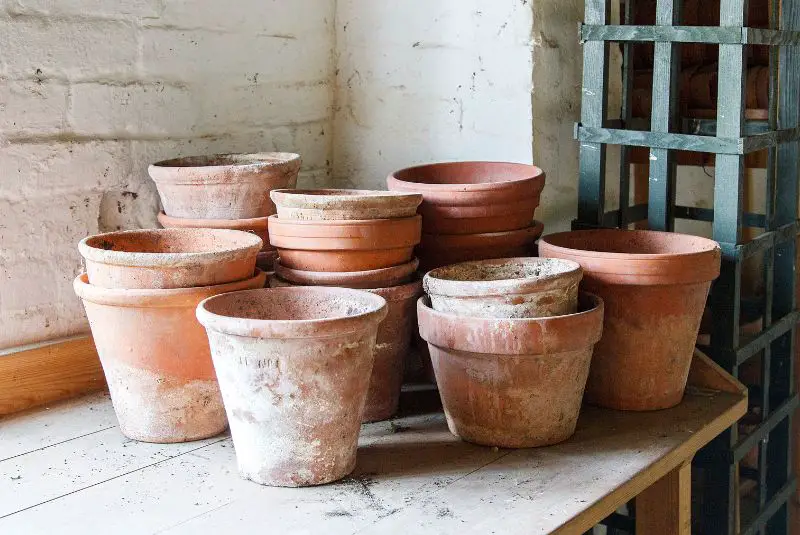
Terracotta Pot Garden Lanterns
I’ve found terracotta pot garden lanterns to be a game-changer for evening ambiance in outdoor spaces.
Here’s how you can make them: place a candle or a string of fairy lights inside a terracotta pot.
If you’re feeling artistic, drill some patterns into the pot for light to peek through, creating a captivating light show after sundown.
Arranging these lanterns along pathways or around seating areas not only lights up the garden but also adds a cozy, enchanting vibe.
Miniature Terracotta Wildlife Habitats
Creating miniature wildlife habitats from terracotta pots is a fantastic way to invite biodiversity into your garden.
Small creatures like toads, bees, and butterflies appreciate these little refuges.
I simply turn a terracotta pot on its side, half-bury it in a secluded garden spot, and fill it with natural materials like straw or twigs to make it welcoming.
These habitats become a sanctuary for beneficial garden fauna, aiding in pollination and pest control while offering an educational peek into wildlife for any onlookers.
Herb Markers and Plant Labels
I’m always looking for ways to remember what I’ve planted where, and terracotta pots come to the rescue as herb markers and plant labels.
Break a pot into large shards, and you’ve got yourself a rustic, eco-friendly canvas for labeling.
With a waterproof marker or paint, I write the names of the herbs or plants directly on the shard and stick it into the soil beside the corresponding plant.
Not only does this add a charming, artisanal touch to the garden, but it also makes identifying and organizing your plants a breeze.
3. Water Features and Irrigation
Thinking about water features and irrigation, terracotta pots offer endless possibilities to beautify and efficiently water your garden.
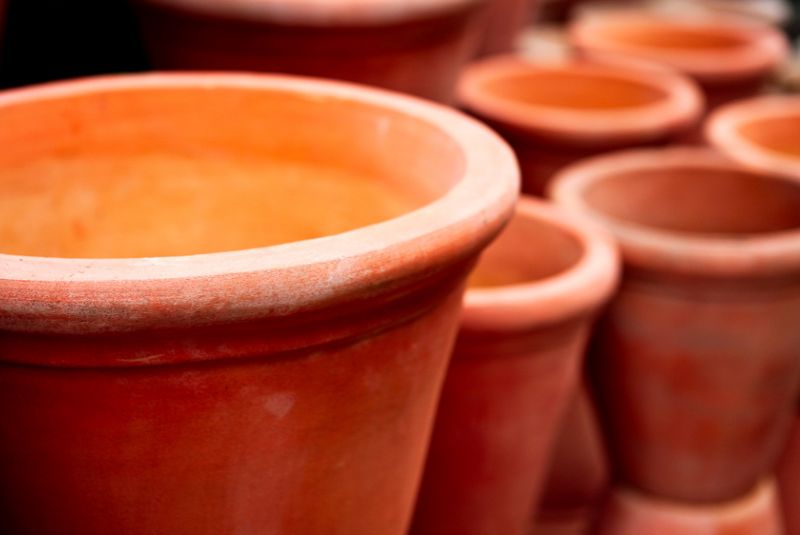
Terracotta Pot Water Fountain
Imagine sitting on your patio, surrounded by lush greenery, with the soothing sound of water trickling in the background.
I’ve found that creating a water fountain from terracotta pots isn’t just easy; it’s a game changer for garden ambiance.
Here’s a simplified guide:
- Select Various Sized Pots: For a dynamic look, choose terracotta pots in different sizes.
- Seal Properly: Ensure the water doesn’t seep out by sealing the pots, focusing on the drainage holes.
- Stack and Assemble: With a small submersible pump at the base, stack the pots with the largest on the bottom, reducing in size as you go up, allowing the water to cascade beautifully down.
- Add Water and Enjoy: Once assembled, fill the base with water, plug in the pump, and revel in the tranquil atmosphere it brings to your space.
This project is surprisingly straightforward, but the result can dramatically elevate your garden’s serene factor.
Olla Irrigation System for Efficient Watering
Olla irrigation has been a game-changer for me, making garden watering both effortless and eco-friendly.
Here’s how to set up your own system:
- Prepare Your Pots: Use unglazed, terracotta pots and seal the drainage hole at the bottom with silicone caulk. Remember to let it cure for 24 hours.
- Bury the Pots: Dig a hole in your garden beds, burying the pots up to their rims, and firmly press the soil around them to ensure stability.
- Fill with Water: Simply fill the pots with water, and they’ll take care of the rest. The pots release moisture slowly, directly to the roots where your plants need it most.
The beauty of this system is that it minimizes water waste and reduces your watering chores significantly.
Mini Ponds with Terracotta Pot Bases
Turning a terracotta pot into a mini pond creates a focal point that attracts wildlife and adds a whimsical touch to your garden. Here’s how:
- Choose a Large Pot: A spacious terracotta pot is essential. Ensure it’s clean and the drainage hole is sealed.
- Add Water and Aquatic Plants: Fill the pot with water. Then, add aquatic plants such as water lilies or fairy moss to create a natural pond ecosystem.
- Place Stones and Accessories: For a finishing touch, arrange stones around the rim and maybe include a small fountain pump for added effect.
Creating a mini pond is incredibly satisfying, and it’s a fantastic way to introduce a water feature without the commitment of a full-sized pond.
4. Enhancing Garden Ecosystems
Terracotta pots are underrated heroes for boosting your garden’s ecosystem.
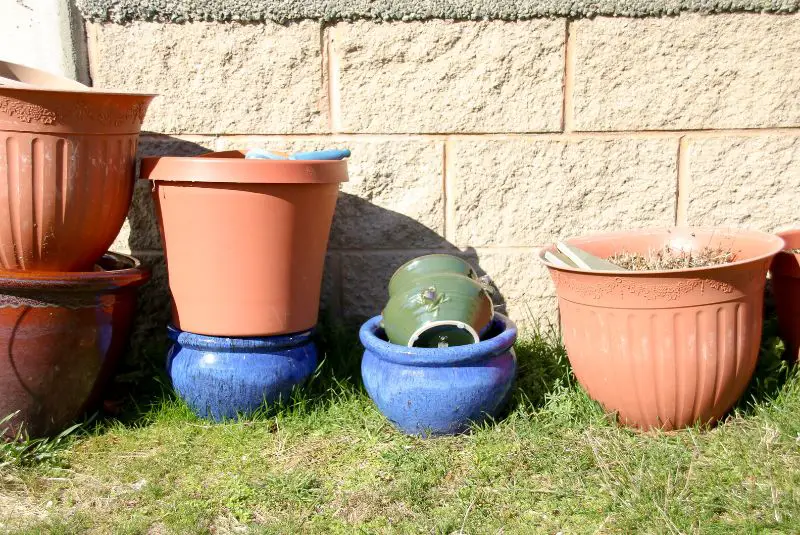
Insect Habitats and Earwig Traps
By strategically placing upside-down terracotta pots filled with straw or wood shavings around my garden, I’ve made cozy homes for beneficial insects.
Adding these pots near plants that need pollination boosts their visitation and helps keep my garden thriving.
Earwigs, though not everyone’s favorite, play a role in the ecosystem by eating decaying plant material and smaller pests.
To manage their numbers, I’ve found that using terracotta pots as traps works wonders.
I simply oil the inside rim of a small pot, invert it on a stick near affected areas, and check it daily, relocating the earwigs to where they can be more beneficial and less harmful.
Toad Abodes for Natural Pest Control
Toads are unsung heroes in the garden, munching on a variety of pests like bugs and slugs. To encourage these helpful amphibians, I’ve turned terracotta pots into inviting abodes.
Here’s my favorite hack: I take a large pot, break a small entryway on the rim’s edge, then bury the pot halfway into the soil in a shady spot.
To make it extra cozy, I’ll add some moist soil or moss inside.
Not only does this provide a cool retreat for toads during the hot days, but it also positions them right where I need them for natural pest control.
5. DIY Outdoor Lighting and Candle Holders
Adding a splash of light to your garden can transform it from a plain backyard to an enchanting evening retreat.
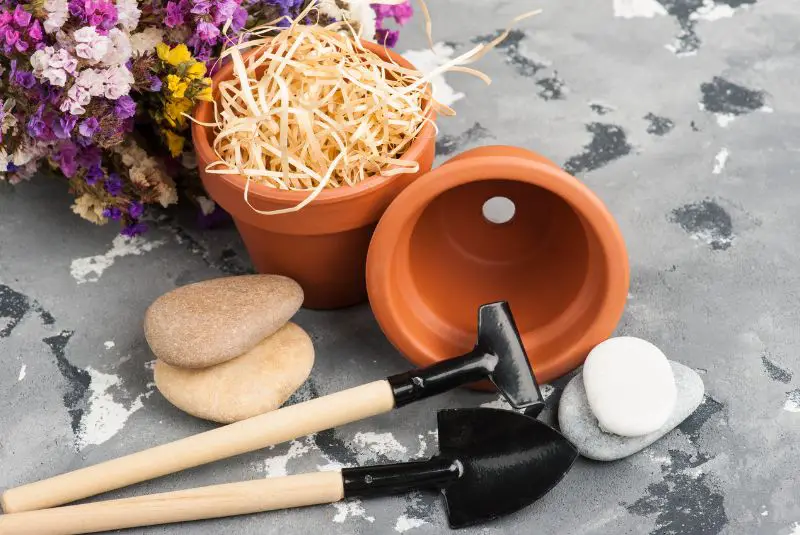
Terracotta Pot Candle Lanterns
I’ve found terracotta pot candle lanterns to be a game-changer for creating a cozy ambiance in any outdoor space.
Here’s a quick guide to making one: First, you’ll need a terracotta pot, ideally one that’s sizeable and fire-safe.
Before starting, give your pot a fresh coat of heat-resistant paint to match your garden’s palette.
Next, add a layer of sand at the base for insulation and place a small can in the center to hold your fuel gas canister.
I prefer using decorative stones or fire-safe glass beads around the canister for that artistic flair.
Not only do these embellishments elevate its aesthetics, but they also add a layer of safety, preventing direct contact with the fiery canister.
Once you’ve got it all set up, lighting it up is all that’s left to do.
These makeshift lanterns aren’t just a source of light; they’re a statement piece that amplifies your outdoor decor.
Remember, safety first – always follow guidelines when lighting and extinguishing your mini fire pit.
Solar Light Terracotta Luminaries
Moving on to a more eco-friendly option, solar light terracotta luminaries are perfect for those of us wanting to brighten up garden paths or driveways without increasing our carbon footprint.
The idea is simple yet effective: use a terracotta flower pot as a holder for solar stake lights.
This not only reuses existing materials but also introduces a charming element to your garden’s walkways.
To create one, place a solar light into the pot, ensuring it’s secure and upright.
You might want to fill around the light with pebbles or sand for added stability.
Arrange these luminaries along desired paths, and they’ll soak up the sun during the day and softly illuminate your garden at night.
It’s a win-win: you get an aesthetically pleasing lighting solution that’s also kind to the environment.
Plus, setting these up is a fun project that won’t take up too much of your time.
6. Versatile Structures for Climbing Plants
Terracotta pots aren’t just for housing plants; they can play a key role in supporting them too.
Terracotta Pot Plant Towers
Building a terracotta pot tower offers a fantastic way to support your climbing plants with flair and functionality.
I’ve found layering terracotta pots, starting from the largest at the base to the smallest at the top, creates a striking vertical garden structure.
You’ll need a sturdy rod or a long wooden dowel placed through the drainage holes to secure the pots in a cascade.
This setup not only supports climbers like sweet peas or jasmine but also adds an eye-catching element to any garden space.
Climbing plants naturally weave through the spaces between the pots, creating a living sculpture. It’s a breeze to set up and looks incredibly chic.
Teacup Tower for Small Vines
For gardeners dealing with smaller spaces or looking for a more whimsical touch, crafting a teacup tower from terracotta pots can be a real game-changer.
I love using smaller pots or even teacup-shaped terracotta pots for this project.
They’re perfect for petite climbers like ivy or certain varieties of ferns that desire a bit of support without overwhelming space.
Arrange the pots in a staggered pattern on a central stake, much like the larger pot tower, but tailor the size and spacing according to the growth habit of your plants.
This dainty tower not only supports your delicate vines but also adds a storybook charm to patio corners or balcony railings.
7. Upcycled Broken Pot Ideas
Give those cracked or broken terracotta pots around the garden a new lease on life. Transforming them into something beautiful not only reduces waste but also adds a unique touch to your garden.
Terracotta Pot Mosaics for Garden Art
I’ve always been a fan of turning the ordinary into something extraordinary. That’s exactly what you can do with broken terracotta pots.
Creating mosaic art offers an appealing way to reuse these pieces.
Here’s how I go about it: I gather various broken pot pieces, ensuring they’re clean and free of sharp edges.
Then, I arrange them into a pleasing design on a stepping stone or directly onto the soil as a decorative garden border.
Using weather-resistant adhesive, I secure the pieces in place and fill the gaps with grout.
Once it’s all set, you’ve got yourself a stunning piece of garden art that’s sure to catch the eye.
It’s a simple yet effective way to add a splash of color and personal flair to your outdoor space.
Creating Your Own Fairy Garden
I find that there’s something inherently magical about mini fairy gardens, and what better base for your enchanting creation than a broken terracotta pot?
I like to use the uneven edges and depth of a broken pot to create a multi-level fairy landscape.
To start, I fill the base with soil and then add in miniature plants—think small ferns and succulents—for lush greenery.
I then accessorize with tiny fairy garden decorations, like little houses, bridges, and even mini garden tools, to bring the scene to life.
If the pot is large enough, I’ll sometimes create a pathway winding through the garden using small pebbles or sand.
Placed in a shady spot or on a patio table, this fairy garden becomes a delightful focal point that sparks the imagination.
It’s a great way to repurpose broken pots while engaging in a fun, creative project.
8. Additional Creative Twists
Here’s more inventive ways to breath new life into terracotta pots, making your garden the envy of the neighborhood.
Outdoor Tabletop with Terracotta Pot Base
Creating an outdoor tabletop using a terracotta pot as the base is simpler than it sounds, and it adds a rustic charm to any garden setup.
Here’s how I do it: I start by selecting a large, sturdy terracotta pot that can support the weight of a tabletop.
Then, I find a circular piece of wood or any flat, solid surface that fits the top of the pot perfectly.
To secure the top, I use a waterproof adhesive or a couple of bolts, depending on the materials I’m working with.
This setup isn’t just for show; it’s a functional piece that’s perfect for holding your morning coffee or a small array of potted plants.
If you’re going for a cohesive look, painting the pot and tabletop with weather-resistant paint is a great touch.
Terracotta Pot Bird Baths and Feeders
Turning a terracotta pot into a bird bath or feeder is another great way to attract wildlife to your garden.
For bird baths, I flip a large pot upside down and top it with a saucer large enough for birds to perch on and splash around.
To make sure it’s stable, I sometimes use a bit of adhesive between the pot and saucer.
For a feeder, I follow a similar setup but instead of water, I fill the saucer with birdseed.
9. Seasonal and Holiday Usage
Terracotta pots aren’t just for planting; they’re a blank canvas for every holiday on the calendar.
Themed Terracotta Pot Decorations
I’ve found repurposing terracotta pots for themed decorations is a hit, especially during the holidays.
For Halloween, I love turning small terracotta pots upside down to craft little pumpkin decorations.
I paint them orange, add a green stem on top, and voilà – a mini pumpkin patch!
Come Christmas, painting pots to look like Santa, his elves, or reindeer adds a playful touch to my decor.
Don’t forget a coat of sealant if you’re displaying them outdoors. This is a fun activity to get the kids involved in, too!
Seasonal Herb and Flower Displays
Switching up the contents of terracotta pots to match the season keeps my garden feeling fresh all year round.
In spring, I fill them with sweet-smelling herbs like basil and cilantro – they love the drainage that terracotta provides.
When summer rolls around, I swap these for vibrant flowers like marigolds and petunias, creating a kaleidoscope of color.
Fall calls for chrysanthemums and ornamental kale, setting the tone with their rich hues.
In winter, although outdoor planting might not be feasible, I use terracotta pots indoors with evergreens or festive poinsettias to keep the greenery going till spring. It’s an easy way to keep your garden or home vibrant, no matter the season.